Experimental and numerical investigation of mid-infrared laser in Pr3+-doped chalcogenidefiber∗
Hua Chen(陈华),Ke-Lun Xia(夏克伦),Zi-Jun Liu(刘自军),†,Xun-Si Wang(王训四),Xiang-Hua Zhang(章向华),Yin-Sheng Xu(许银生) and Shi-Xun Dai(戴世勋)
1 Laboratory of Infrared Materials and Devices,Advanced Technology Research Institute,Ningbo University,Ningbo 315211,China
2 Key Laboratory of Photoelectric Detection Materials and Devices of Zhejiang Province,Ningbo 315211,China
3 Laboratory of Glasses and Ceramics,UMR CNRS 6226,University of Rennes 1,Rennes Cedex 135042,France
Keywords:mid-infrared fiber laser,chalcogenide glass fiber,rare earth doped glass fiber,laser modelling
1.Introduction
The broadband optical transmission of chalcogenide glasses in the infrared range offers a wide range of potential applications,such as biological and chemical sensing,nonlinear optics,or optical fibers.[1-5]Notably,selenium-based glasses transmit in the second(3µm-5µm)and third(8µm-12µm)atmospheric windows.Moreover,selenium glasses,as potential mid-IR laser media,have low phonon energy values and high refractive index values,which result in low probability of de-excitation due to multiphonon relaxation and high absorption/emission cross-section.[6-9]Since 1982,when Reisfeld first reported the spectral characteristics of Er3+-,Nd3+-,and Ho3+-doped Ga-La-S and Al-La-S glasses,many scholars have conducted research on the infrared emission of rare earth-doped chalcogenide glasses.[10]In the near-infrared case,some progress in fiber amplifiers and lasers has been made,including the Nd:1.08-µm continuous fiber laser output and the fiber optic amplification and the optical fiber ampli fication of Pr3+ions 1.34µm with a maximum internal gain of 6.8 dB at a pump power of 180 mW.[11,12]However,reports on the mid-infrared cases are mainly concentrated on the fluorescence of glasses and fibers.Studies at home and abroad have shown that although rare earth-doped chalcogenidefibers are the best gain medium for mid-infrared fiber lasers,many problems still remain unsolved,which limits their development and applications.The main problems that stop this technology include the difficulty in manufacturing high-purity rare earth-doped chalcogenidefibers and the self-terminating effect,which makes achieving population inversion difficult.
The Ge-As-Ga-Se(GAGS)glass system has a low tendency to crystallize,high mechanical properties,and high solubility for rare-earth ions.Shiryaev et al.[13]provided a new vapor phase transport approach to purify and add the batch of metallic gallium into the silica glass reactor for the GAGS glass synthesis.The content of residual impurities of Se-H can be reduced to 0.023 cm-1.Among the rare-earth dopants,praseodymium is among best to exploit the generation of radiation with 3µm-5µm wavelength.However,the upperenergy level of Pr3+ion has a long lifetime,which results in a selfterminating effect and makes achieving population inversion difficult.The cascade lasing scheme is an effective solution to depopulate the(3F2,3H6)levels and significantly improve the 4.89-µm laser output power.[3,6,14]
In this work,the cascade lasing approach was used to enhance efficiency and was numerically investigated.To obtain realistic results,the Ge10As24Ga4Se62-Pr0.1mol%(GAGSPr0.1mol%)glasses and fibers were prepared and measured for further calculation and analysis.The emission spectra of the fiber and glass under 2.0-µm laser excitation were then compared.The modeling parameters were directly extracted from the FTIR absorption measurements of the fabricated bulk glass samples using J-O theory and McCumber theory.[15-17]For the proposed laser structures,a numerical model of the threelevel fiber laser was developed with the Pr3+doping concentration of 0.1 mol%(4.5×1025ions/m3),and the dependence of laser performance on fiber length,pump power,doping concentration,and fiber losses were calculated.Moreover,the effect of the idler laser on the in fluence of the signal laser power wasdiscussed.Finally,to maximize the outputpower,the fiber laser structural parameters were optimized by using a particle swarm optimization(PSO)algorithm.
2.Numerical model
Figure 1 illustrates the fiber laser cavity composed of two suitable fiber Bragg gratings(FBGs)mirrors.In this model,fiber gratings trapped the idler light at∼3.7µm to promote lasing at∼4.89µm.The reflectivity of the input FBG2/1 for the idler R1and signal wavelength R3are all 0.95.The output reflectivity was 0.05 for the signal R4and 0.95 for the idler wavelength R2.

Fig.1.Schematic illustration of the Pr3+-doped chalcogenidefiber laser cavity.
Figure 2 illustrates the Pr3+ion leveldiagram by pumping at the wavelength of 2.04µm.Relevant transitions between the three lowest levels of Pr3+are spontaneous transitions and stimulated emission and absorption transitions between each pair of levels.The rare earth behavior can be modelled as a three-level laser system.
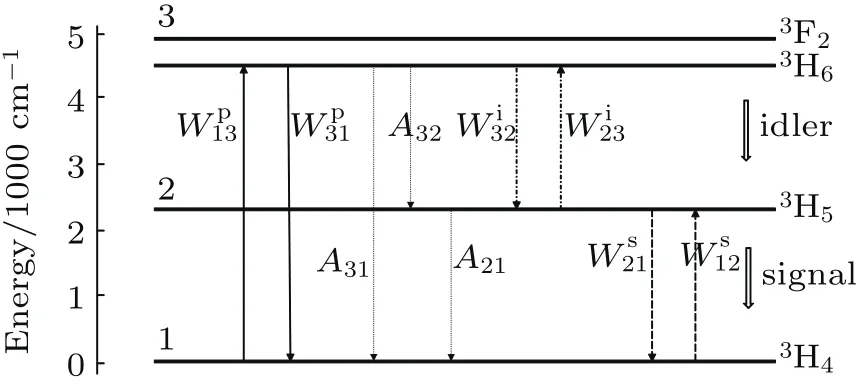
Fig.2.Three-level model of praseodymium.The most important phenomena are represented(absorption and emission).
Pump light at 2.04µm is coupled into the Pr3+chalcogenide glass fiber,where it promotes Pr3+ions to the(3F2,3H6)(level 3).Moreover,the3F2level will be transferred to the3H6level through non-radiative transitions quickly due to the multi-phonon relaxation,so that the3F2and3H6levels can be considered as one level.[18]Transition from this level to the3H5(level 2)occurs and is accompanied by fluorescence between 3.3µm and 4.5µm.Lasing at a wavelength within this range is obtained using two fiber Bragg gratings(FBG1)tuned to 3.7µm.Fluorescence from level 2 to the ground state3H4(level 1)occurs between 3.8µm and 5.7µm,and simultaneous lasing at a wavelength within this range is obtained using two additional fiber Bragg gratings(FBG2)tuned to 4.89µm.
In steady state,the rate equations can be represented in the following matrix,which forms a set of three algebraic equations:

The coefficients in the equations are as follows:C11=where τ3and τ2are the lifetime of levels 3 and 2,respectively,β32is the branching ratio of transition of levels 3 to 2,Niwith i=1,2,3 are the steady-state ion populations of the i-th Pr3+energy level.[19]
The stimulated rates for the pump,signal,and idler are given by

where x=p represents the pump,s represents the signal,and i represents the idler;Γxis the confinement factor;σijis the absorption or emission cross-section for the ij transition;and Pxdenotes the propagating signal and pump powers,respectively.A is the doping cross-section area,h is Planck’s constant,and c is the speed of light in free space.
The laser power propagation equations are as follows:

P(z)=P+(z)+P-(z)is the optical mode power(superscript‘+’represents the forward propagating beam and superscript‘-’represents the backward propagating beam).The coupled equations(1)-(3)were solved self-consistently using the coupled solution method.
3.Experiment and calculation

Fig.3.Absorption spectrum(a)and mid-infrared emission spectral(b)of the 0.1-mol%Pr3+:GAGS glass and fiber.
Figure 3(a)shows the absorption spectra of 0.1-mol%Pr3+:Ge10As24Ga4Se62glasses. The absorption band at 2.94µm is assigned to O-H impurity vibrational absorption.The absorption band observed at 4.5µm is attributed to the ground state electronic absorption band3H5→3H4and also encompasses Se-H extrinsic impurity vibrational absorption.In the actual calculation,this should be reasonably deducted.Figure 3(b)shows the photoluminescence intensity of the 0.1-mol%Pr3+for bulk and fiber sample together to compare their band shapes.The fiber sample exhibits a greater proportion of its observed emission intensity at wavelengths>4800 nm compared with the bulk sample.This method is expected due to the longer path length of the fiber sample.For emission in the fiber,the shorter wavelength emission overlaps with the absorption from the ground state(3H5→3H4).Therefore,the shorterwavelength emission is self-absorbed and then re-emitted at longer wavelengths.The emission spectra were measured for the calculation of emission cross-sections.
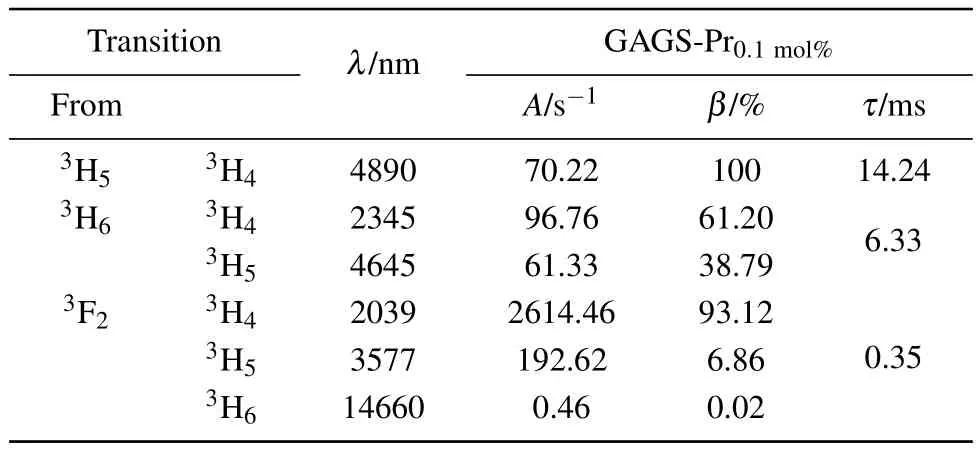
Table 1.Probable radiative electron transitions in Pr3+ions with corresponding wavelengths,spontaneous emission probabilities,A,branching rations β ,and the radiative lifetime τ.
The J-O theory can quantitatively calculate the luminous intensity of rare earth ions in a certain precision.The number of spectral absorption bands that have been used in the J-O computations for Pr3+contains six peaks(Fig.3(a))centered at 1022,1478,1584,2039,2345,and 4890 nm.[20,21]To minimize the error,the measured FTIR spectra were corrected by extracting the baseline,each represented by atleast 50 selected points.This procedure yielded nine sets of J-O parameters.
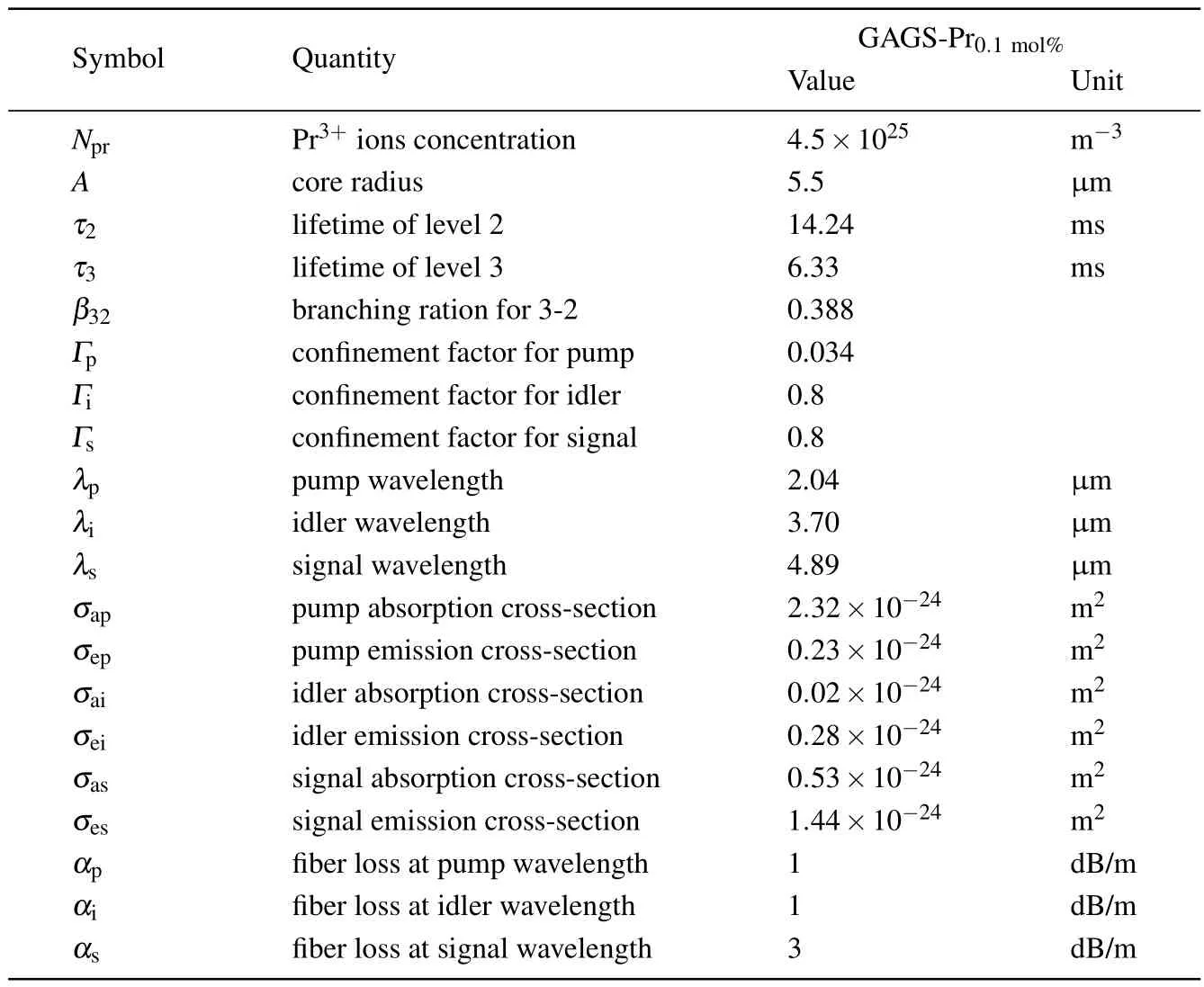
Table 2.Parameters used for simulations of Pr3+-doped chalcogenidefiber lasers.
Radiative transition probabilities(A),branching ratios(β),and radiative lifetime(τ)of the excited states of Pr3+were calculated based on the J-O theory and are summarized in Table 1.Based on these data,the absorption cross sections for each wavelength were calculated,and the emission crosssections were determined from the measured emission spectra(Fig.3(b))and from the spontaneous radiative transition probabilities,A,by using the Füchtbaure-Ladenburg relation,which are all shown in Table 2.
In this modeling,considering the feasibility of the laser’s design,the Pr3+concentration 4.5×1025ions/m3was selected. The GAGS fiber doped with 4.5×1025ions/m3of Pr3+allows to achieve a favorable compromise for easy implementation of fiber drawing,optical attenuation,and fluorescence.[22]The minimum background losses of the GAGS-Pr glass fibers are about 1 dB/m at 2µm and 4µm and 3 dB/m at 4.89µm.To avoid a deleterious nonlinear effect,the maximum pump power is set to 5 W.
4.Results and discussions
Figure 4 shows the optical signal power Ps(L)of the Pr3+-doped fiber laser versus fiber length L for different pump wavelengths.The dopant concentration NPr=4.5×1025ions/m3and mirror reflectivity(R3=0.95,R4=0.05)were fixed.Based on the experimental data,Pr3+has strong absorption bands at 1.55µm and 2.04µm,and the absorption cross-sections are 1.5×10-24m2and 2.32×10-24m2,respectively.In this study,the detailed calculation of the four-level mode forthe 1.55-µm pump was notexhibited.To improve the accuracy of the simulation,the fiber loss values are varied according to the wavelength.The results plotted for a fiber with a background loss of pump and idler wavelengths are 1 dB/m,and the signal wavelength is 3 dB/m.The energy efficiency is higher,and the optimal fiber length is shorter when pumped by 2.04µm.This result arises because the absorption crosssection at 2.04µm is larger than that at 1.55µm.Therefore,in a shorter fiber length,the power of the pump light is absorbed almost completely.In the future,we will further study the difference between the two pump lasers.
Figure 5(a)shows the dependence of output power on the cavity length for different levels of fiber background loss.The maximum output signal power was 1.41 W for 1.28 m cavity length,with fiberloss of1 dB/m.For fiberloss fixed at3 dB/m,the maximum output signal power was reduced to 1.07 W for a fiber length of 0.97 m.A rapid decrease of the output power and the optimal fiber length Lmaxwas observed with the increase of fiber background loss.A bigger fiber background loss leads to faster pump power depletion and a reduced signal power and short optimal fiber length.To make a more comprehensive analysis of the proposed fiber laser,the in fluence of background loss on laser performance was investigated.Background loss is a limiting factor that hampers the possibility of achieving mid-IR laser action from selenide-doped fibers.Selenide glass possesses high optical absorption loss at wavelengthsaround 4.5µm due to Se-Hglassimpurities.However,the loss in this spectral region has recently been proven to be reduced to 1.6 dB/m in the host glass by using sophisticated glass purification techniques.[23]The calculated output power as a function of fiber background loss is presented in Fig.5(b).The mirror reflectivity(R3=0.95,R4=0.05)was fixed.The output power decreases from 1.33 W to 0.26 W as fiber loss increased from 1 dB/m to 9 dB/m.Output power above 300 mW is expected for a fiber loss<6 dB/m.Therefore,to obtain efficient laser operation,the fiber loss should be reduced below 6 dB/m.
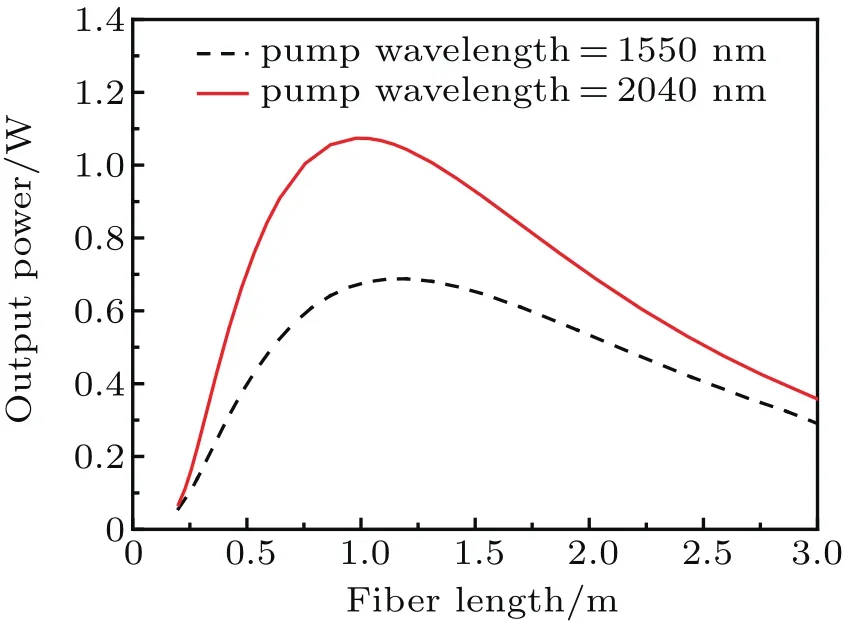
Fig.4.Calculated signal laser power(λs=4.89 µm)as a function of fiber length for different pump wavelengths.
Figure 6(a)shows the optical signal power Ps(L)of the Pr3+-doped fiber laser versus length L for different levels of dopant concentration NPr.In the actual fiber laser design,to get a higher output power,a reasonable fiber length is dependent on the doping concentration.As the doping concentration increases,the optimum fiber length will be shorter,and the maximum output power will be higher.Figure 6(b)shows the optical signal power Ps(L)of the Pr3+-doped fiber laser versus dopant concentration NPrfor different input pump powers.The mirrors reflectivity(R3=0.95,R4=0.05)were fixed.From Fig.6(b),we can see that when the doping concentration of rare earth ions exceeds 4.5×1025ions/m3,the power enhancement is slow due to the limitation of the pump power.Furthermore,the increase in doping concentration causes the homopolar interaction to increase.Because of the concentration quenching in the emission glasses,we chose 4.5×1025ions/m3as the optimal concentration.
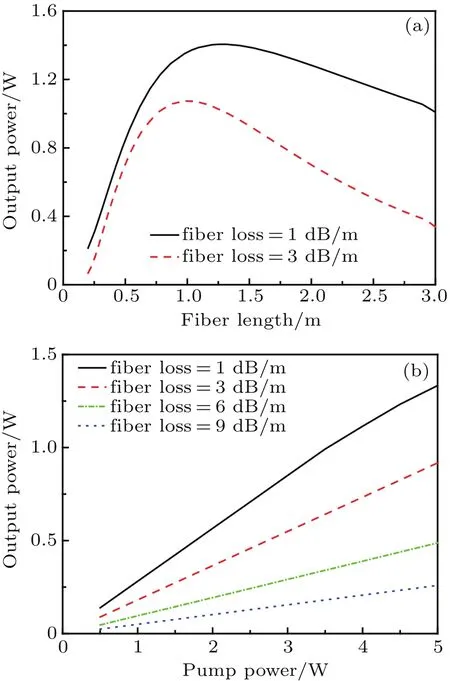
Fig.5.Optical signal power P s of the Pr3+-doped fiber laser versus the fiber length L for different levels of fiber background loss(a).The signal output power as a function of input pump power for different fiber background losses(b).

Fig.6.Optical signal power P s of the Pr3+-doped fiber laser versus fiber length L for different levels of dopant concentration(a).Optical signal power P s(L)of the Pr3+-doped fiber laser versus input pump power for different dopant concentrations(b).
Figure 7(a)shows the optical signal power Ps(L)of the Pr3+-doped fiber laser versus output mirror reflectivity R4for different pump powers.The results are plotted for a fiber laser with a background loss of 1 dB/m at 2.04µm and 3.7µm and 3 dB/m at 4.89µm.Decreasing the output mirror reflectivity leads to increase in signal output power.The results presented in Fig.7(a)show that the highest output power can be achieved for an output mirror reflectivity of 0.05 at 4.89µm.Figure 7(b)shows the optical signal power Ps(L)of the Pr3+-doped fiber laser versus fiber length for the idler.Figure 7(a)shows that with the increase of R4,the output signal power monotonically decreased.According to Fig.7(b),the existence of idler can effectively improve the signal output power.This result is because the idler laser promotes the de-excitation of the level(3F2,3H6)faster.Furthermore,such structure promotes the reabsorption of the idler light and improves the cross-relaxation transition probability between(3F2,3H6)→3H5,and3H4→3H5in the Pr3+that can effectively enhance the signal power and energy efficiency.[24]This method will reduce the threshold and improve energy conversion efficiency.Therefore,in the actual research,we should consider reducing R4and increasing R2to increase the laser output power.
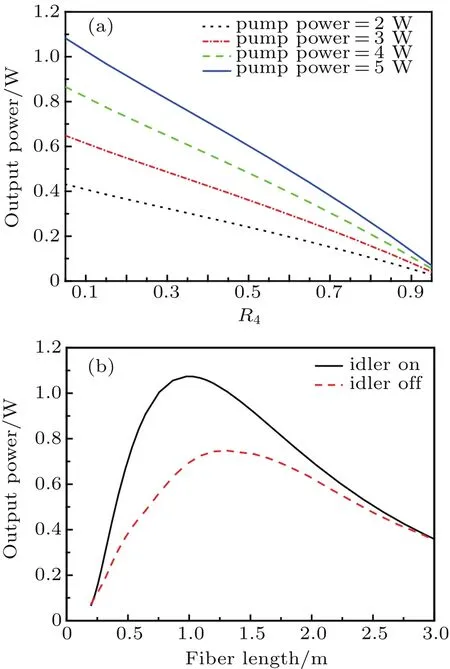
Fig.7.Optical signal power P s(L)of the Pr3+-doped fiber laser versus output mirror reflectivity R4 for different pump powers(a).Calculated laser power as a function of fiber length(b).Two cases are considered:without idler and with idler.
The output power of a fiber laser is affected by many parameters that improve the flexibility of the laser design while making the optimization of the laser output power difficult to accomplish by simple trial and error.In fact,the power of the laser is nonlinearly related to the output mirror reflectivity,fiber length,and dopant concentration.To overcome this problem,the Particle Swarm Optimization(PSO)[25,26]approach is employed to globally optimize the optical source.PSO is a computational method that optimizes a problem by iteratively trying to improve a candidate solution with regard to a given measure of quality,which is a relatively recent heuristic inspired by the choreography of a bird flock.This solves the problem by having a population of candidate solutions,here dubbed particles,and moving these particles around in the search-space according to simple mathematical formulae over the particle’s position and velocity.Each particle’s movement is in fluenced by its local best known position and is also guided toward the best known positions in the search-space,which are updated as better positions are found by other particles.This is expected to move the swarm toward the best solutions.
Figure 8(a)shows the effects of fiber length and laser output mirror reflectivity on the output of the laser.The input pump power is Pp(0)=5 W,the dopant concentration is NPr=4.50×1025ions/m3,and the mirrors reflectivity is R1=R2=R3=95%.It allows a quick identification of the best fiber laser configuration via a three-dimensional plot.
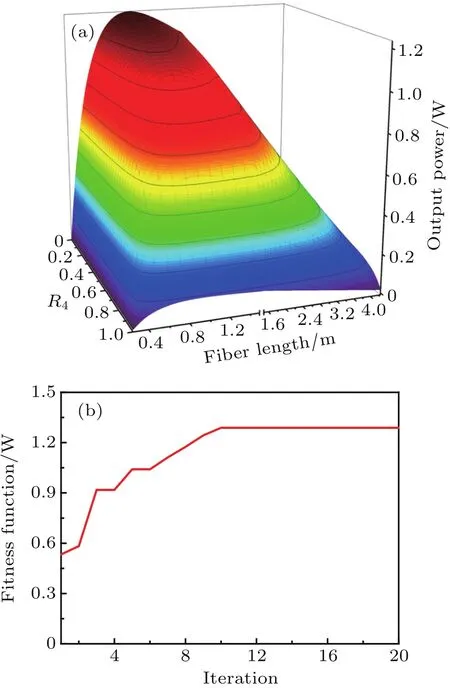
Fig.8.Output power of the Pr3+-doped fiber laser versus laser cavity length L and output mirror reflectivity R4(a).Global best fitness value versus iteration(b).
Figure 8(b)illustrates PSO fitness function(signal output power)versus the iteration number.After iteration for about 10 times,the maximum output power is obtained.The parameters used for optimization are the laser cavity length,output signal reflectivity R4,and dopant concentration NPr.The input pump power is Pp(0)=5 W,and the mirror reflectivity is R1=R2=R3=95%.The laser output reached 1.28 W,and the energy efficiency can reach 25%with background loss of 3 dB/m.The optimal parameters calculated by the particle swarm method are L=0.94 m,R4=0.02,and NPr=4.22×1025ions/m3.These results indicate that chalcogenide glass fiber doped with praseodymium is a good candidate for constructing an efficient fiber laser working in the mid-IR wavelength range.
5.Conclusions
In this paper,a GAGS glass fiber doped with Pr3+has been prepared and studied.We have systematically investigated the dependences of pump wavelengths,cascade structure,and fiber features,and also output mirror reflectivity on the laser’s performance.We have demonstrated that threelevel fiber lasing is feasible in Pr3+-doped GAGS glass fiber.We observed strong mid-IR emission in the range of 3.5µm-5.2µm and a lifetime of 14.24 ms for the3H5→3H4transition.These numerical simulations suggest that the proposed cascade lasing scheme will result in a highly efficient laser compared with a traditional single laser wavelength scheme.The output power function is optimized by the particle swarm optimization algorithm to obtain the maximum output power.Our simulations show that an output signal power of 1.28 W and energy efficiency of 25%at 4.89-µm wavelength can be achieved with Pp(0)=5 W,R1=R2=R3=95%,L=0.94 m,R4=0.02,NPr=4.22×1025ions/m3,with fiber loss at 3 dB/m.
——记绥棱县靠山乡靠山村驻村工作队原队长兼第一书记陈华
- Chinese Physics B的其它文章
- Physics of quantum coherence in spin systems∗
- Recent progress of infrared photodetectors based on lead chalcogenide colloidal quantum dots∗
- Progress in quantum well and quantum cascade infrared photodetectors in SITP∗
- Recent advances in Ga-based solar-blind photodetectors∗
- Development of long-wavelength infrared detector and its space-based application requirements∗
- Transition of photoconductive and photovoltaic operation modes in amorphous Ga2O3-based solar-blind detectors tuned by oxygen vacancies∗

